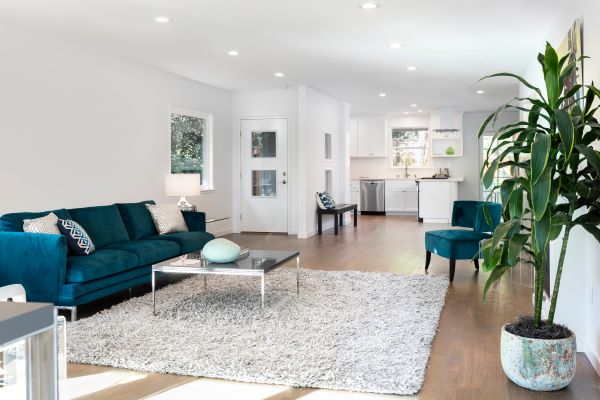No products in the cart.
Soundproofing Your Home: Living Room Edition

12
Jan
There are several spaces that are commonly soundproofed within a home like a bedroom, nursery, man cave; the options are endless. One room that is suprisingly yet commonly overlooked is the living room. Many people don’t think about soundproofing a living room because it is an open area where noise is to be expected. Though, it can be beneficial in many ways. By using products and materials made for sound absorption, you can minimize loud disruptions caused by neighbors. This can be a courtesy to your neighbors as well, especially if you enjoy hosting friends and family in your home. There are several ways to decrease the noise that may leave and enter your home; our blog post will cover methods that are suitable for each individual!
Ways to Soundproof Your Living Room
Seal Gaps and Openings Around Surfaces to Prevent Sound Leaks
The first step to soundproofing a living room is to seal gaps around areas such as doors, windows, and walls. Although these gaps are usually miniscule, it creates a higher probability of noise leaking in and out of a room. Luckily, this is an easy problem to fix. Gaps and openings can be sealed with caulk, an efficient and cheap solution. Caulk is a user-friendly product that can be purchased online or in several department stores. Using this product to seal gaps won’t work as a soundproofing method alone, but it is a simple and quick way to prevent noise leaks.

Use a Soundproof Curtain Over Windows to Block Sound
Most living rooms are filled with multiple windows, which are an easy access point for sound waves to enter a room. When neighboring houses are close together, it is very likely to hear disturbances made by neighbors since sound waves can easily travel through windows and walls. Installing a soundproof curtain over a window in your living room will do wonders. The AcousticCurtain is heavy, thick, and designed to block sound that may enter a space. You can also customize the curtain to fit several dimensions of windows within your living room. By reducing up to 60-80% of sound, your living room will be transformed into a quieter and more relaxing space.
See Similar: Soundproofing a Room: Man Cave Edition
Utilize Bookshelves and Furniture to Reduce Sound Deflection
Furniture is used functionally and decoratively in a living room, but it can also be arranged in a certain way to reduce sound deflections. Sound bounces off hard surfaces like walls and floors, so positioning furniture in a way that will cover those surfaces will minimize noise levels. Bookshelves can be used for this as well since they are dense objects that absorb noise. Rearranging the furniture in your living room, as well as potentially buying more items, will decrease the likelihood of an echoey space.
Upgrade the Entrance Door or Use a Door Curtain to Minimize Noise
The entrance door to one’s home may be located near the living room, which can be distracting and bothersome when it comes to noise. If you live on a busy street or in a loud neighborhood, these noises can easily leak through the front door if not soundproofed properly. There are many ways to soundproof the front door whether that may be upgrading to a solid-core door, using a soundproof curtain, and/or installing a door sweep. A hollow-core door is common in homes because it is inexpensive, but a solid-core door is more valuable and insulates sound and heat. If you would rather not replace your door, you can hang a soundproof curtain over it. The AcoustiDoor weighs between 10-15 pounds, made of a sound-blocking core, and provides customers with an easy installation process. Additionally, you can place a door sweep at the foot of the door which will prevent noise leaks.
Soundproofing Your Home: Living Room Edition – Conclusion
After reading this article, you should be familiar with soundproofing methods for a living room and what is most suitable for you. The list goes on, but the steps we provided are some of the most common ways to make a space quieter. Although it is more difficult to soundproof an open space like a living room, it is still possible. Let’s review the several options for soundproofing a living room:
- Seal Gaps and Openings Around Surfaces to Prevent Sound Leaks
- Use a Soundproof Curtain Over Windows to Block Sound
- Utilize Bookshelves and Furniture to Reduce Sound Deflection
- Upgrade the Entrance Door or Use a Door Curtain to Minimize Noise
